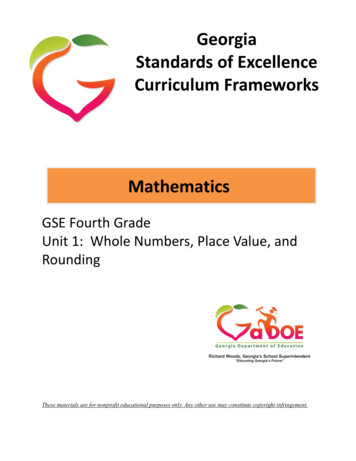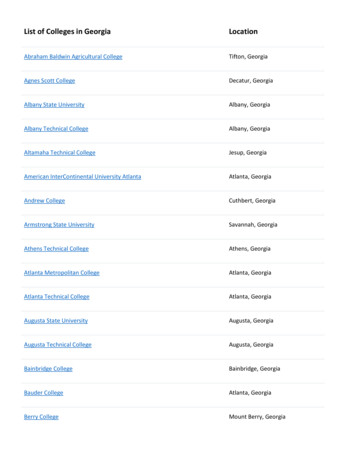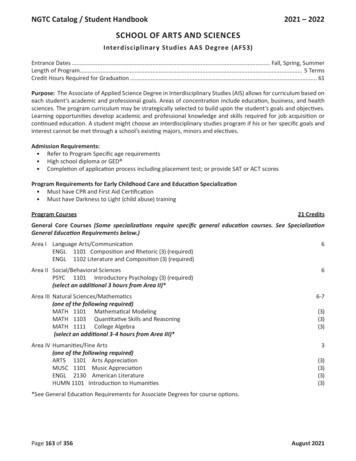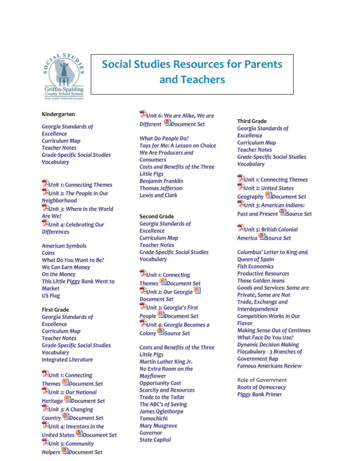
Transcription
GeorgiaStandards of ExcellenceCurriculum FrameworksGSE Fourth GradeUnit 1: Whole Numbers, Place Value, andRoundingThese materials are for nonprofit educational purposes only. Any other use may constitute copyright infringement.
Georgia Department of EducationGeorgia Standards of Excellence FrameworkGSE Whole Numbers, Place Value and Rounding Unit 1Unit 1: WHOLE NUMBERS, PLACE VALUE, AND ROUNDINGTABLE OF CONTENTSOverview .3Standards for Mathematical Practice 3Standards for Mathematical Content .4Big Ideas .5Essential Questions for the Unit .5Concepts & Skills to Maintain .5Strategies for Teaching and Learning .6Selected Terms and Symbols .6Tasks .7Intervention Table . .11Formative Assessment Lessons .12TASKS What Comes Next?.13 Relative Value of Places .17 Number Scramble .23 Super Bowl Numbers .27 Ordering and Comparing Numbers . .33 NFL Salaries . .38 Nice Numbers . 46 Estimation as a Check . 50 Making Sense of the Algorithm . .54 Reality Checking .58 Culminating Task: It’s in the Numbers!.66Classroom video available here: es-it-Look-Like-When-youImplement-a-Task.aspxYOU HAVE NOT READ THE FOURTH GRADE CURRICULUM OVERVIEW IN ITSENTIRETY PRIOR TO USE OF THIS UNIT, PLEASE STOP AND CLICK dards/Frameworks/4th-Math-Grade-LevelOverview.pdf Return to the use of this unit once you’ve completed reading the CurriculumOverview. Thank you.Mathematics GSE Fourth Grade Unit 1: Whole Numbers, Place Value and RoundingRichard Woods, State School SuperintendentJuly 2021 Page 2 of 72All Rights Reserved
Georgia Department of EducationGeorgia Standards of Excellence FrameworkGSE Whole Numbers, Place Value and Rounding Unit 1OVERVIEWIn this unit students will: read numbers correctly through the millions write numbers correctly through millions in standard form write numbers correctly through millions in expanded form identify the place value name for multi-digit whole numbers identify the place value locations for multi-digit whole numbers round multi-digit whole numbers to any place fluently solve multi-digit addition and subtraction problems using the standardalgorithm solve multi-step problems using the four operationsAlthough the units in this instructional framework emphasize key standards and big ideas at specifictimes of the year, routine topics such as estimation, mental computation, and basic computationfacts should be addressed on an ongoing basis. The first unit should establish these routines,allowing students to gradually enhance their understanding of the concept of number and to developcomputational proficiency.To assure that this unit is taught with the appropriate emphasis, depth, and rigor, it is important thatthe tasks listed under “Big Ideas” be reviewed early in the planning process. A variety of resourcesshould be utilized to supplement the tasks in this unit. The tasks in these units illustrate the types oflearning activities that should be utilized from a variety of sources.For more detailed information about unpacking the content standards, unpacking a task, mathroutines and rituals, maintenance activities and more, please refer to the Grade Level CurriculumOverview for fourth grade.STANDARDS FOR MATHEMATICAL PRACTICEThis section provides examples of learning experiences for this unit that support the development ofthe proficiencies described in the Standards for Mathematical Practice. These proficienciescorrespond to those developed through the Literacy Standards. The statements provided offer a fewexamples of connections between the Standards for Mathematical Practice and the ContentStandards of this unit. This list is not exhaustive and will hopefully prompt further reflection anddiscussion.1. Make sense of problems and persevere in solving them. Students make sense of problemsinvolving place value and rounding in computation.2. Reason abstractly and quantitatively. Students demonstrate abstract reasoning aboutrelative size of numbers.3. Construct viable arguments and critique the reasoning of others. Students construct andcritique arguments regarding number strategies including addition and subtraction orrounding strategies.Mathematics GSE Fourth Grade Unit 1: Whole Numbers, Place Value and RoundingRichard Woods, State School SuperintendentJuly 2021 Page 3 of 72All Rights Reserved
Georgia Department of EducationGeorgia Standards of Excellence FrameworkGSE Whole Numbers, Place Value and Rounding Unit 14. Model with mathematics. Students use base ten materials to demonstrate understanding ofa multi-digit whole number.5. Use appropriate tools strategically. Students select and use tools such as place value chartsand base ten materials to identify patterns within the base ten system.6. Attend to precision. Students attend to the language of real-world situations to determine ifaddition and subtraction answers are reasonable.7. Look for and make use of structure. Students relate the structure of the base ten system torecognize that in a multi-digit whole number, a digit in one place represents ten times whatit represents in the place to its right.8. Look for and express regularity in repeated reasoning. Students relate the structure ofthe base ten system to explain that in a multi-digit whole number, a digit in one placerepresents ten times what it represents in the place to its right.***Mathematical Practices 1 and 6 should be evident in EVERY lesson. ***STANDARDS FOR MATHEMATICAL CONTENTUse the four operations with whole numbers to solve problems.MGSE4.OA.3 Solve multistep word problems with whole numbers and having whole-numberanswers using the four operations, including problems in which remainders must be interpreted.Represent these problems using equations with a symbol or letter standing for the unknownquantity. Assess the reasonableness of answers using mental computation and estimation strategiesincluding rounding.Generalize place value understanding for multi-digit whole numbers.MGSE4.NBT.1 Recognize that in a multi-digit whole number, a digit in any one place representsten times what it represents in the place to its right. For example, recognize that 700 70 10 byapplying concepts of place value and division.MGSE4.NBT.2 Read and write multi-digit whole numbers using base-ten numerals, numbernames, and expanded form. Compare two multi-digit numbers based on meanings of the digits ineach place, using , , and symbols to record the results of comparisons.MGSE4.NBT.3 Use place value understanding to round multi-digit whole numbers to any place.Use place value understanding and properties of operations to perform multi-digit arithmetic.MGSE4.NBT.4 Fluently add and subtract multi-digit whole numbers using the standard algorithm.Mathematics GSE Fourth Grade Unit 1: Whole Numbers, Place Value and RoundingRichard Woods, State School SuperintendentJuly 2021 Page 4 of 72All Rights Reserved
Georgia Department of EducationGeorgia Standards of Excellence FrameworkGSE Whole Numbers, Place Value and Rounding Unit 1Solve problems involving measurement and conversion of measurements from a larger unit toa smaller unit.MGSE4.MD.2 Use the four operations to solve word problems involving distances, intervals oftime, liquid volumes, masses of objects, and money, including problems involving simple fractionsor decimals, and problems that require expressing measurements given in a larger unit in terms of asmaller unit. Represent measurement quantities using diagrams such as number line diagrams thatfeature a measurement scale.BIG IDEAS The value of a number is determined by the place of its digits. Using rounding is an appropriate estimation strategy for solving problems and estimating. Rounded numbers are approximate and not exact. Exact answers can be rounded todifferent place values. A number can be written using digits in standard form, word, or expanded form. Larger numbers can be compared using the place value of the digits within the numbers.The relationship between the two numbers can be expressed using the symbols , , or .ESSENTIAL QUESTIONSChoose a few questions based on the needs of your students: How does our base ten number system work?How does understanding the base-ten number system help us add and subtract?How does the value of a digit change if its location is changed in a large number?What determines the value of a digit?How does estimation help us understand large numbers?How are large numbers estimated?What conclusions can I make about the places within our base ten number system?What happens to a digit when it is multiplied and divided by 10?What effect does the location of a digit have on the value of the digit?How can we compare large numbers?What determines the value of a number?Why is it important for me to be able to compare numbers?What is a sensible answer to a real problem?What information is needed in order to round a whole number to any place?How can I ensure my answer is reasonable?How can rounding help me compute numbers?What effect does a remainder have on my rounded answer?What strategies can I use to help me make sense of a written algorithm?CONCEPTS/SKILLS TO MAINTAINIt is expected that students will have prior knowledge/experience related to the concepts and skillsidentified below. It may be necessary to pre-assess in order to determine if time needs to be spenton conceptual activities that help students develop a deeper understanding of these ideas. Place value understanding for multi-digit whole numbers Round a whole number to the nearest ten or hundred Fluently add and subtract within 1000 using strategiesMathematics GSE Fourth Grade Unit 1: Whole Numbers, Place Value and RoundingRichard Woods, State School SuperintendentJuly 2021 Page 5 of 72All Rights Reserved
Georgia Department of EducationGeorgia Standards of Excellence FrameworkGSE Whole Numbers, Place Value and Rounding Unit 1Fluency: Procedural fluency is defined as skill in carrying out procedures flexibly, accurately,efficiently, and appropriately. Fluent problem solving does not necessarily mean solving problemswithin a certain time limit, though there are reasonable limits on how long computation should take.Fluency is based on a deep understanding of quantity and number.Deep Understanding: Teachers teach more than simply “how to get the answer” and insteadsupport students’ ability to access concepts from a number of perspectives. Therefore, students areable to see math as more than a set of mnemonics or discrete procedures. Students demonstrate deepconceptual understanding of foundational mathematics concepts by applying them to newsituations, as well as writing and speaking about their understanding.Memorization: The rapid recall of arithmetic facts or mathematical procedures. Memorization isoften confused with fluency and automaticity. Fluency implies a much richer kind of mathematicalknowledge and experience.Number Sense: Students consider the context of a problem, look at the numbers in a problem,make a decision about which strategy would be most efficient in each particular problem. Numbersense is not a deep understanding of a single strategy, but rather the ability to think flexibly betweena variety of strategies in context.Fluent students: flexibly use a combination of deep understanding, number sense, and memorization. are fluent in the necessary baseline functions in mathematics so that they are able to spendtheir thinking and processing time unpacking problems and making meaning from them. are able to articulate their reasoning. find solutions through a number of different paths.For more about fluency, see: /FluencyWithoutFear-2015.pdf and ATEGIES FOR TEACHING AND LEARNINGStudents should be actively engaged by developing their own understanding.Mathematics should be represented in as many ways as possible using graphs, tables,pictures, symbols, and words. Appropriate manipulatives and technology should be used to enhance student learning. Students should be given opportunities to revise their work based on teacher and peerfeedback, as well as metacognition, which includes self-assessment and reflection. Students should write about the mathematical ideas and concepts they are learning. SELECTED TERMS AND SYMBOLSNote – At the elementary level, different sources use different definitions. Please preview anywebsite for alignment to the definitions given in the frameworks. The glossary of mathematicalterms and it can be found at:Mathematics GSE Fourth Grade Unit 1: Whole Numbers, Place Value and RoundingRichard Woods, State School SuperintendentJuly 2021 Page 6 of 72All Rights Reserved
Georgia Department of EducationGeorgia Standards of Excellence FrameworkGSE Whole Numbers, Place Value and Rounding Unit tics-glossary/glossary. The terms below arefor teacher reference only and are not to be memorized by the students. algorithmdigitsestimateexpanded formnumbersnumeralsperiodplace valueroundingTASKSThe following tasks represent the level of depth, rigor, and complexity expected of all fourth-gradestudents. These tasks or tasks of similar depth and rigor should be used to demonstrate evidence oflearning. It is important that all elements of a task be addressed throughout the learning process sothat students understand what is expected of them. While some tasks are identified as a performancetasks, they also may be used for teaching and learning.Scaffolding TaskConstructing TaskPractice TaskPerformance TaskCulminating TaskIntervention TableFormativeAssessment Lesson(FAL)CTE ClassroomTasksTasks that build up to the learning task.Constructing understanding through deep/rich contextualized problemsolving tasks.Tasks that provide students opportunities to practice skills andconcepts.Tasks, which may be a formative or summative assessment, that checksfor student understanding/misunderstanding and or progress toward thestandard/learning goals at different points during a unit of instruction.Designed to require students to use several concepts learned during theunit to answer a new or unique situation. Allows students to giveevidence of their own understanding toward the mastery of the standardand requires them to extend their chain of mathematical reasoning.The Intervention Table provides links to interventions specific to thisunit. The interventions support students and teachers in fillingfoundational gaps revealed as students work through the unit. All listedinterventions are from New Zealand’s Numeracy Project.Lessons that support teachers in formative assessment which bothreveal and develop students’ understanding of key mathematical ideasand applications. These lessons enable teachers and students tomonitor in more detail their progress towards the targets of thestandards.Designed to demonstrate how the Career and Technical Educationknowledge and skills can be integrated. The tasks provide teachers withrealistic applications that combine mathematics and CTE content.Mathematics GSE Fourth Grade Unit 1: Whole Numbers, Place Value and RoundingRichard Woods, State School SuperintendentJuly 2021 Page 7 of 72All Rights Reserved
Georgia Department of EducationGeorgia Standards of Excellence FrameworkGSE Whole Numbers, Place Value and Rounding Unit 13-Act TaskA Three-Act Task is a whole-group mathematics task consisting of 3distinct parts: an engaging and perplexing Act One, an information andsolution seeking Act Two, and a solution discussion and solutionrevealing Act Three. More information along with guidelines for 3-ActTasks may be found in the Guide to Three-Act Tasks ongeorgiastandards.org.Mathematics GSE Fourth Grade Unit 1: Whole Numbers, Place Value and RoundingRichard Woods, State School SuperintendentJuly 2021 Page 8 of 72All Rights Reserved
Georgia Department of EducationGeorgia Standards of Excellence FrameworkGSE Whole Numbers, Place Value and Rounding Unit 1Task NameTask Type/GroupingStrategyContent AddressedStandard(s)Scaffolding TaskPartner/Small Group TaskRelative size of numbersMGSE4.NBT. 1Students work with base tenmaterials to experience that aplace value in a number is tentimes more than the digit to itsright.Constructing TaskPartner/ Small GroupTaskRelative size of numbersMGSE4.NBT.2MGSE4.NBT. 1Students work with dotty arraypieces to understand patternswithin the base-ten numbersystem. Students solve placevalue problems to showunderstanding of the patternslearned.Practice TaskIndividual/Partner TaskMaking and NamingLarge NumbersMGSE4.NBT.2Students create numbers givenspecific directions and write thosenumbers in standard, word andexpanded form.3 Act TaskIndividual/Partner TaskComparing Multi-DigitNumbers, Adding Multidigit NumbersMGSE4.NBT.2MGSE4.NBT.4Students make connectionsbetween the base-ten numbersystem and the Roman Numeralnumber system.Practice TaskIndividual/Partner TaskOrdering Larger NumbersMGSE4.NBT.2Students order and comparenumbers through a dice gameplayed with a partner.What Comes Next?Relative Value ofPlacesNumber ScrambleSuper BowlNumbersOrdering andComparing NumbersDescription of TaskMathematics GSE Fourth Grade Unit 1: Whole Numbers, Place Value and RoundingRichard Woods, State School SuperintendentJuly 2021 Page 9 of 72All Rights Reserved
Georgia Department of EducationGeorgia Standards of Excellence FrameworkGSE Whole Numbers, Place Value and Rounding Unit 13 Act TaskIndividual/Partner TaskComparing Multi-DigitNumbers, Adding Multidigit NumbersMGSE4.OA.3MGSE4.NBT.4Constructing TaskPartner/Small group TaskRounding, 4.MD.2Constructing TaskIndividual/ Partner TaskRounding, Adding,Subtracting multi-digitnumbersMGSE4.NBT.4MGSE4.NBT.3Students find estimated solutionsto problems.Constructing TaskIndividual/Partner TaskFluently subtractingmulti-digit numbersMGSE4.NBT.4Students write about strategiesthat are used for given problemsin the task, leading to a discussionof procedures within thesubtraction standard algorithm.Reality CheckingConstructing TaskIndividual/ Partner TaskOrdering, Adding,Subtracting andRounding 3MGSE4.MD.2Students apply knowledge of theaddition and subtraction standardalgorithm in order to balance amock check registry.It’s in the NumbersCulminating TaskIndividual TaskCalculation andEstimation with MD.2Students gather data aboutpopulations in the U.S. to drawconclusions about why peoplechoose to live in certain regionsof the country.NFL SalariesNice NumbersEstimation as aCheckMaking Sense of theAlgorithmShould you need further support for this unit, please view the appropriate unit webinar /default.aspxMathematics GSE Fourth Grade Unit 1: Whole Numbers, Place Value and RoundingRichard Woods, State School SuperintendentJuly 2021 Page 10 of 72All Rights ReservedStudents compare salaries offootball players to discuss whycertain players are paid aparticular amount of money.Students apply rounding conceptsto find estimated solutions toword problems.
Georgia Department of EducationGeorgia Standards of Excellence FrameworkGSE Whole Numbers, Place Value and Rounding Unit 1INTERVENTION TABLEThe Intervention Table below provides links to interventions specific to this unit. The interventions support students and teachers in fillingfoundational gaps revealed as students work through the unit. All listed interventions are from the Georgia Numeracy Project.Cluster of StandardsGeneralize place valueunderstanding for multi-digitwhole numbers.MGSE4.NBT.1MGSE4.NBT.2MGSE4.NBT.3Use place value understanding andproperties of operations to performmulti-digit arithmetic.MGSE4.NBT.4Name ofInterventionSnapshot of summary or Student I can statement. .Number Fans to aMillionNumber Hangmanto a MillionPlace Value Housesto a MillionTo a Million andBeyondWhen One Numberis Near a HundredReversing AdditionChecking Additionand Subtraction byEstimationIdentify all of the numbers in the range 01,000,000.Identify all of the numbers in the range 01,000,000.Identify all of the numbers in the range 01,000,000.Order whole numbers in the range 0-1,000,000.Mental or Written?A Standard WrittenForm for AdditionSolve addition and subtraction problems bycompensating with tidy numbers.Solve subtraction problems by using addition.Choose critically from a range of mental strategiesto solve addition and subtraction problems.Solve addition and subtraction problems usingdecomposition, leading to a written algorithm.Solve addition and subtraction problems usingdecomposition, leading to a written algorithm.Mathematics GSE Fourth Grade Unit 1: Whole Numbers, Place Value and RoundingRichard Woods, State School SuperintendentJuly 2021 Page 11 of 72All Rights Reserved
Georgia Department of EducationGeorgia Standards of Excellence FrameworkGSE Whole Numbers, Place Value and Rounding Unit 1FORMATIVE ASSESSMENT LESSONS (FALS)Formative Assessment Lessons are designed for teachers to use in order to target specificstrengths and weaknesses in their students’ mathematical thinking in different areas. A FormativeAssessment Lesson (FAL) includes a short task that is designed to target mathematical areasspecific to a range of tasks from the unit. Teachers should give the task in advance of the delineatedtasks and the teacher should use the information from the assessment task to differentiate thematerial to fit the needs of the students. The initial task should not be graded. It is to be used toguide instruction.Teachers may use the following Formative Assessment Lessons (FALS) Chart to help themdetermine the areas of strengths and weaknesses of their students in particular areas within the uded)Content AddressedPacing(Use before and after these tasks)Ordering 4-digitNumbersOrdering Larger NumbersWhat Comes NextBuild 1,000Relative Value of PlacesNumber ScrambleTicket MasterTo Regroup or Notto RegroupUsing the AdditionAlgorithmNice NumbersEstimation as a CheckMaking sense of an AlgorithmReality CheckingMathematics GSE Fourth Grade Unit 1: Whole Numbers, Place Value and RoundingRichard Woods, State School SuperintendentJuly 2021 Page 12 of 72All Rights Reserved
Georgia Department of EducationGeorgia Standards of Excellence FrameworkGSE Whole Numbers, Place Value and Rounding Unit 1SCAFFOLDING TASK: What Comes Next?(Adapted from Teaching Student Centered Mathematics Volume 2)Back to Task TableTASK CONTENT: This task helps pre-assess students' previous knowledge and misconceptionsabout place value and number sense.STANDARDS FOR MATHEMATICAL CONTENTMGSE4.NBT.1 Recognize that in a multi-digit whole number, a digit in any one place representsten times what it represents in the place to its right. For example, recognize that 700 70 10 byapplying concepts of place value and division.STANDARDS FOR MATHEMATICAL PRACTICE1. Make sense of problems and persevere in solving them.2. Reason abstractly and quantitatively.3. Construct viable arguments and critique the reasoning of others.4. Model with mathematics.5. Use appropriate tools strategically.6. Attend to precision.7. Look for and make use of structure.8. Look for and express regularity in repeated reasoning.BACKGROUND KNOWLEDGEThis task helps pre-assess students' previous knowledge and misconceptions about placevalue and number sense. The strategies they use to solve the problem demonstrate students'understanding about a number of concepts including place value, grouping, computation, numbersense, patterns, and mathematical communication.COMMON MISCONCEPTIONSTwo important ideas developed for three-digit numbers should be extended to largernumbers. First, the grouping idea should be generalized. That is, ten in any position makes a singlething (group) in the next position, and vice versa. Second, the oral and written patterns for numbersin three digits are duplicated in a clever way for every three digits to the left. These two relatedideas are not as easy for students to understand as adults seem to believe. Because models for largenumbers are often difficult to demonstrate or visualize, textbooks frequently deal with these ideas ina predominantly symbolic manner. That is not sufficient! (Van de Walle, page 47-48)ESSENTIAL QUESTIONS How does our base ten number system work?How does understanding the base-ten number system help us add and subtract?Mathematics GSE Fourth Grade Unit 1: Whole Numbers, Place Value and RoundingRichard Woods, State School SuperintendentJuly 2021 Page 13 of 72All Rights Reserved
Georgia Department of EducationGeorgia Standards of Excellence FrameworkGSE Whole Numbers, Place Value and Rounding Unit 1MATERIALS base-ten blocksbase ten materials grid #14 from ia/objects/3464/3547873/blackline masters/BLM 14.pdfGROUPINGStudents work in groups or pairs.NUMBER TALKSIn the Fourth Grade Curriculum Overview, the importance of giving students opportunities tomentally compute and explain computational strategies is discussed. Number Talks is an excellentway to do this. 5 to 15 minutes each day is dedicated to students sharing the ownership ofdetermining whether answers are accurate, and given the expectation of thinking through allsolutions and strategies carefully (Parrish, 2010). During the Number Talk, the teacher is not thedefinitive authority. The teacher is the facilitator and is listening and learning for and from thestudents’ natural mathematical thinking. The teacher gives a problem on the board in whole groupor small group setting. The students mentally solve the problem and share with the whole groupHOW they arrived at their answer. They must justify and defend their answer and their thinking.The teacher simply records the students’ thinking and poses extended questions to draw out deeperunderstanding for all. To let the teacher know they are ready, they make a fist and place it on theirchest. If they have two strategies to share, they place two fingers on their chest and so on.Some lessons lend themselves to Number Talks better than others. You may modify/change thembased on the needs of your students. Number Talks suggestions are included in tasks whereappropriate.TASK DESCRIPTION, DEVELOPMENT AND DISCUSSIONThroughout the year, you will be incorporating Number Talks into your daily mathematicaldiscussions. Number Talks is based on the premise of mental computations which means studentswill rely heavily on place value knowledge and understanding. The following task will causethe students to focus on number relationships and use these relationships to develop efficient,flexible strategies with accuracy (Parrish, page 13). It is important for students to realize that thenumber system does have a logical structure, is not totally arbitrary, and can be understood (Van deWalle, page 166).Students will be able to compose or make large numbers up to 1000 using base 10. Thistask will aid the students in their conceptual understanding of composing numbers which will laterlead to them decomposing numbers when doing expanded notation and calculating mentally duringthe computation of addition, subtraction, multiplication, and division. This lesson by Van de Walleis full of rigor for the student and teacher and worth the conceptual understanding of anumber.Mathematics GSE Fourth Grade Unit 1: Whole Numbers, Place Value and RoundingRichard Woods, State School SuperintendentJuly 2021 Page 14 of 72All Rights Reserved
Georgia Department of EducationGeorgia Standards of Excellence FrameworkGSE Whole Numbers, Place Value and Rounding Unit 1 Students will use paper models of base-ten strips and squares to complete this activity. (Seethe attached website in the “Materials” section of the lesson to download the BlacklineMaster.) After passing out the materials, ask students, “What piece of the base ten materials can beused to represent one?” (The unit or ones piece is a one cm square and can be used torepresent one.) Then ask students, “What is next?” Discuss with students that ten centimeter squares can begrouped to make the tens piece. The tens piece is a 10 cm by 1 cm strip. Ask students again, “What is next?” Discuss with students that ten strips that are 10 cm by1 cm can be grouped together to form the hundreds piece. The hundreds piece is a 10 cm by10 cm square. Again, pose the question, “What is next?” Allow students to turn and talk with a partnerabout what can be made next and how it will be made. (Placing ten 10 cm by 10 cm squarestogether is ten hundreds, or a thousand.) Ask students, “What shape would a thousand be?”Tape together a long strip made of ten paper hundreds squares. Continue the discussion by asking students, “What comes next?” Reinforce the idea of tenmaking one that has progressed to this point. Ten thousand strips would make a squaremeasuring one meter on each side making a
For more detailed information about unpacking the content standards, unpacking a task, math routines and rituals, maintenance activities and more, please refer to the Grade Level Curriculum Overview for fourth











